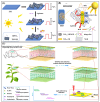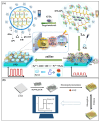Recent Advances in Hydrogel-Promoted Photoelectrochemical Sensors
- PMID: 40862984
- PMCID: PMC12384467
- DOI: 10.3390/bios15080524
Recent Advances in Hydrogel-Promoted Photoelectrochemical Sensors
Abstract
Photoelectrochemical (PEC) sensors have garnered increasing attention due to their high sensitivity, low background signal, and rapid response. The incorporation of hydrogels into PEC platforms has significantly expanded their analytical capabilities by introducing features such as biocompatibility, tunable porosity, antifouling behavior, and mechanical flexibility. This review systematically categorizes hydrogel materials into four main types-nucleic acid-based, synthetic polymer, natural polymer, and carbon-based-and summarizes their functional roles in PEC sensors, including structural support, responsive amplification, antifouling interface construction, flexible electrolyte integration, and visual signal output. Representative applications are highlighted, ranging from the detection of ions, small biomolecules, and biomacromolecules to environmental pollutants, photodetectors, and flexible bioelectronic devices. Finally, key challenges-such as improving fabrication scalability, enhancing operational stability, integrating emerging photoactive materials, and advancing bio-inspired system design-are discussed to guide the future development of hydrogel-enhanced PEC sensing technologies.
Keywords: detection; hydrogel; photoelectrochemical sensors.
Conflict of interest statement
The authors declare no conflicts of interest.
Figures













References
-
- Sun B., Ai S. Fabrication and Application of Photoelectrochemical Sensor. Prog. Chem. 2014;26:834–845. doi: 10.7536/pc131014. - DOI
-
- Tu W., Wang Z., Dai Z. Selective photoelectrochemical architectures for biosensing: Design, mechanism and responsibility. TrAC Trends Anal. Chem. 2018;105:470–483. doi: 10.1016/j.trac.2018.06.007. - DOI
Publication types
MeSH terms
Substances
Grants and funding
LinkOut - more resources
Full Text Sources

